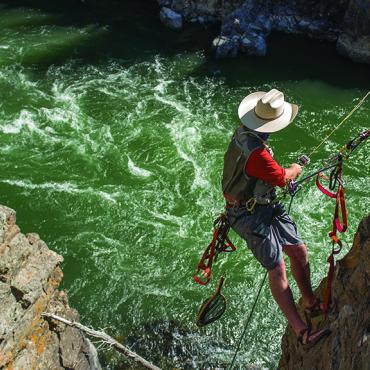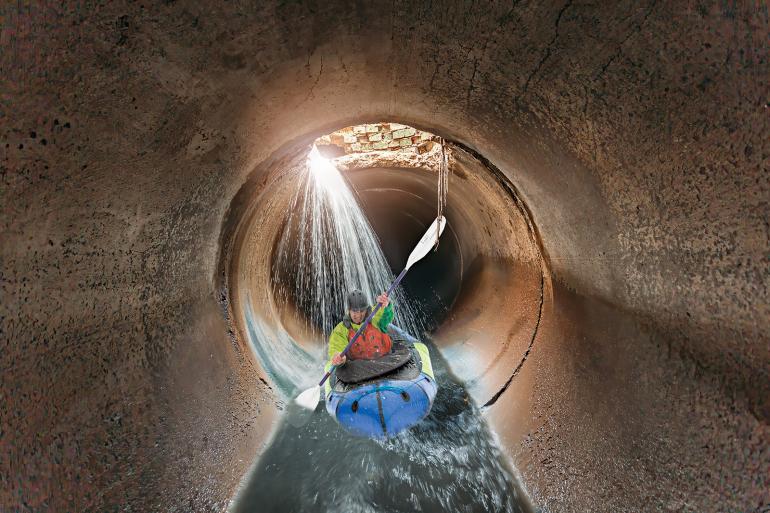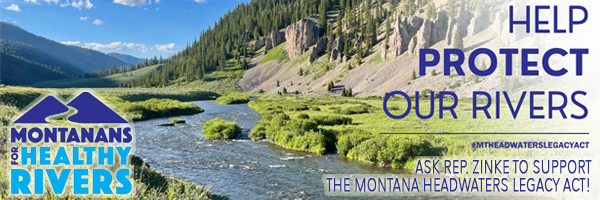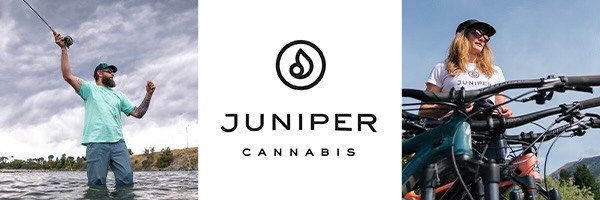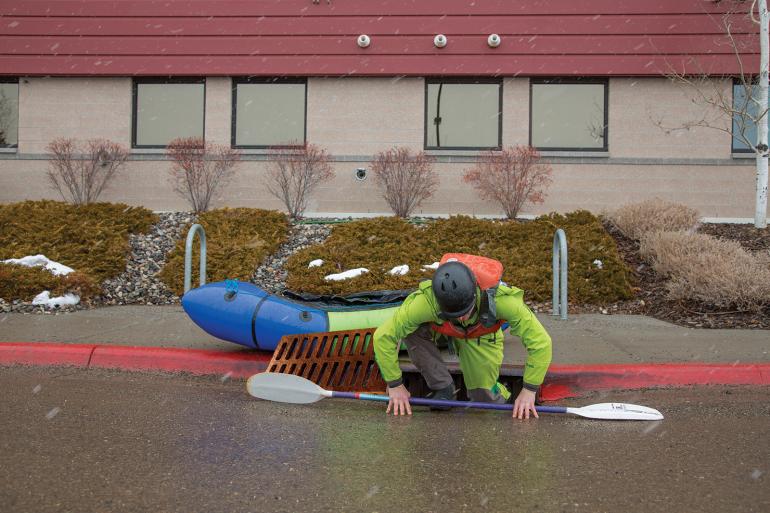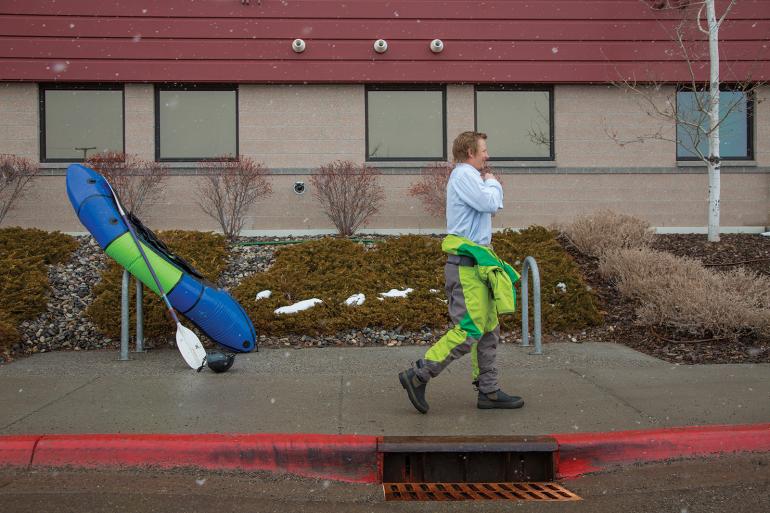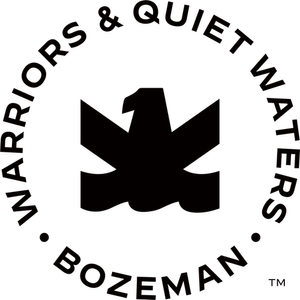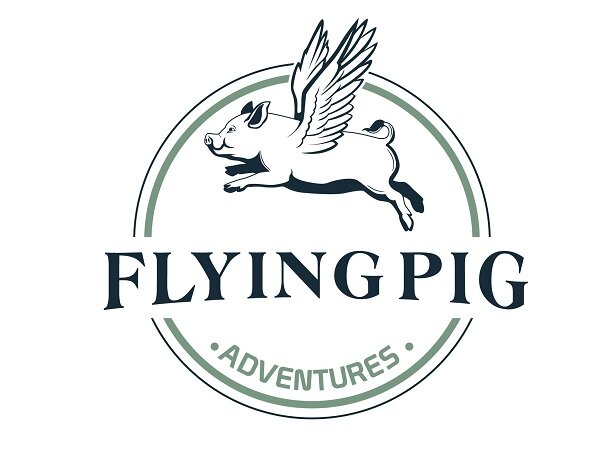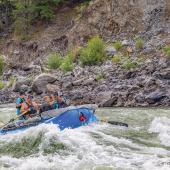The Low Road
A new commute beneath the Bozone.
We’ve all been there: driving home after a taxing day at work, the Bridgers burnished with alpenglow. All you want to do is get to the house, walk the canine, rip the bike during the last hour of daylight, or do anything outside to be reminded of the joys of this great place. But 19th is jammed—and appropriately named, since driving one mile takes 19 minutes. The green lights mean nothing as you creep home one car-length at a time. Precious daylight fades away. You turn onto a cross-street, seeking reprieve with a detour, only to find the same scene. Cars honk at bikers, who flip the bird in return. This metropolis-level congestion is one of the consequences of a rapidly growing city. Thankfully, Bozeman breeds ingenuity, and there’s a subterranean solution sprouting wings—or rather, fins—as residents look to take back their commutes.
The logistics are simple: find the nearest storm-drain access, toss in whatever floating vessel fits, and dart around the generally un-trafficked pipes with paddle power.
That’s right, Bozemanites are getting off the pavement and out of their cars by paddling their way to work. Their routes? The ever-expanding web of storm drains underneath the pavement. Commuters hop into manholes and use the underground infrastructure to zip around town. This radical solution to traffic and dangerous biking conditions also serves as a morning workout, creating another activity for FitBit-banging fitness freaks to track their caloric output.
The logistics are simple: find the nearest storm-drain access, toss in whatever floating vessel fits, and dart around the generally un-trafficked pipes with paddle power—imagine a low-budget Pirates of the Caribbean. Then pop out at your destination, and boom, you’ve cut your commute in half, re-claiming hours of your life per year—not to mention an improved emotional state. “It’s kind of meditative, in a Ram Dass meets Roto-Rooter–type way,” says Sue Ehratt, an early adoptee of the storm-drain commute. “Especially my morning downstream leg. I just sit back, put on the Joe Rogan Experience, and practice deep mouth-breathing. It smells pretty bad down there.”
Most of the crafts found in these underground highways are what you’d imagine: paddleboards, packrafts, and small inflatable kayaks. The city, hoping to promote pipeline travel and relieve the bottlenecked streets, has installed free-to-use inflatable pumping stations at common entry points such as downtown, the MSU campus, and the Cat’s Paw. Soon they’ll provide 24-foot catarafts for boat-pooling downtown during peak hours of 7-9am and 4-6pm, and, if funding is secured—ideally, by paying the city manager less than the average heart surgeon—storm-drain ports for folks to moor their vessels, eliminating the burden of pulling out of the pipes every day. Down the road, the city will add a fleet of Venice-style gondolas to accommodate tourist demands. Plans are underway for “Storm Drains of Bozeman’s Rich & Famous,” a reality show that will include luxury cruises under the homes of Conrad Anker, Steven Rinella, and Greg Gianforte.
Adding to the amenities of the commute, coffee shops like Timberline Café are contributing to the cause with paddle-through coffee stops. Every hour, the roasters dump the bottom of their coffee pots straight into the storm drains. Commuters can bring their own cups, dip them into the swill, and enjoy a gritty cup o’ joe for free. “It might not be the best sludge,” says Ehratt, “but it sure beats the four-bucks-a-cup crap they sell above ground.”
Alas, all is not smooth sailing in the subsurface byways—unless one possesses the instincts of a tapeworm navigating a large intestine, that is. Navigation has proven a huge hurdle, even with the pinpoint GPS technology available these days. Satellite signals fail to penetrate the ground, and even with offline downloads, paddlers can easily miss their stops in the tangled web of pipes. One underground aquanaut paddled all the way to Headwaters State Park, accidentally completing the first known storm-drain source-to-stream descent of the Bozeman systems. With no universal traffic standards yet established, it’s not uncommon to hear about travelers getting lost for days in the darkness. One such pipe-farer became the first person ever to be treated for seasickness at the Bozeman Hospital. To top off the navigation risks, a lack of cell service means paddlers can’t call Search and Rescue, which may very well be a blessing in disguise given the current stress on the local rescue system. Gallatin Valley SAR has seen a tenfold increase in calls since the completion of the Lowercase M Trail.
Car washes also pose a formidable obstacle to storm-drain travelers, as paddleboarder Cass Kade can attest: “I got stuck behind a curtain of water while paddling underneath Scrubby’s Car Wash,” he recalls. “It was like Ousel Falls during spring runoff, but with suds. Trapped in the dark, in a tube, with water spraying all over, it felt like a scene out of Das Boot. Never thought I’d ever find a reason to pray for a bubble brush to break. But either my prayer was answered, or Scrubby’s hit a late-morning lull—the torrent of water suddenly stopped, allowing me to escape.”
To maintain the status quo of dumping raw sewage into the Gallatin River, the YC is actively trying to stop underground commuters from spreading to the Big Sky area, citing safety concerns.
As word gets out, scrutiny has splashed in from surprising avenues. Out-of-state animal-rights organizations have caught wind of a disturbing side-effect of underground commuting: encroachment on the last remaining habitat of the endangered Rocky Mountain sewer snake. Introduced by 18th-century fur trappers to push muskrats out of their holes, this elusive reptile retreated into municipal sewer systems at the start of the 20th century. Since 2001, there have only been two recorded sightings, and with such mild winters, the snakes are being flooded out of the storm drains earlier and earlier every year. “We really need to think about the impact commuters are having on these pristine riparian areas,” says Ina Fectuall, director of the nonprofit Saving Natural Manmade Spaces. “We’re preparing a plan to research the feasibility of possibly putting together a study about these environmental impacts.”
The Yellowstone Club is also a surprising opponent of tunnel travel. Although the town of Big Sky initially launched their own underground-commuting program, its aim was to create a better experience for Spanish Peaks and YC members who would no longer be subject to the eyesore of employees’ mud-splattered 2002 Honda Civics. But the YC’s risk manager soon pointed out that if people started commuting in the storm-drain system, they would quickly discover that the pipes are in fact the same ones as their sewer system. So, to maintain the status quo of dumping raw sewage into the Gallatin River, the YC is now actively trying to stop these underground commuters from spreading to the Big Sky area, citing safety concerns. They’ve already spent $38 million on campaigning against the subsurface sailors, which is about the same price as constructing a proper sewage-treatment facility.
Will storm-drain commuting remain a practical means of commuting in the long-term? Will environmentalists team up with the Yellowstone Club (talk about strange bedfellows) to shut down these routes? Or will Bozemanites use this novel approach to reclaim their leisure time in this outdoor paradise we call home? Only time will tell. In the meantime, snag yourself a vessel, hop in the pipes, paddle away, and see if you can trim a few minutes off your daily commute. Just remember to bring a headlamp, a coffee cup, and a bottle of Febreze.
To learn more, visit stormdrainsailing.com.

